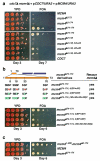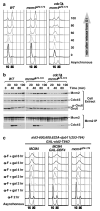The Dbf4-Cdc7 kinase promotes S phase by alleviating an inhibitory activity in Mcm4
- PMID: 20054399
- PMCID: PMC2805463
- DOI: 10.1038/nature08647
The Dbf4-Cdc7 kinase promotes S phase by alleviating an inhibitory activity in Mcm4
Abstract
Eukaryotic DNA replication uses kinase regulatory pathways to facilitate coordination with other processes during cell division cycles and response to environmental cues. At least two cell cycle-regulated protein kinase systems, the S-phase-specific cyclin-dependent protein kinases (S-CDKs) and the Dbf4-Cdc7 kinase (DDK, Dbf4-dependent protein kinase) are essential activators for initiation of DNA replication. Although the essential mechanism of CDK activation of DNA replication in Saccharomyces cerevisiae has been established, exactly how DDK acts has been unclear. Here we show that the amino terminal serine/threonine-rich domain (NSD) of Mcm4 has both inhibitory and facilitating roles in DNA replication control and that the sole essential function of DDK is to relieve an inhibitory activity residing within the NSD. By combining an mcm4 mutant lacking the inhibitory activity with mutations that bypass the requirement for CDKs for initiation of DNA replication, we show that DNA synthesis can occur in G1 phase when CDKs and DDK are limited. However, DDK is still required for efficient S phase progression. In the absence of DDK, CDK phosphorylation at the distal part of the Mcm4 NSD becomes crucial. Moreover, DDK-null cells fail to activate the intra-S-phase checkpoint in the presence of hydroxyurea-induced DNA damage and are unable to survive this challenge. Our studies establish that the eukaryote-specific NSD of Mcm4 has evolved to integrate several protein kinase regulatory signals for progression through S phase.
Figures




Similar articles
-
Dbf4 and Cdc7 proteins promote DNA replication through interactions with distinct Mcm2-7 protein subunits.J Biol Chem. 2013 May 24;288(21):14926-35. doi: 10.1074/jbc.M112.392910. Epub 2013 Apr 2. J Biol Chem. 2013. PMID: 23549044 Free PMC article.
-
Checkpoint-dependent inhibition of DNA replication initiation by Sld3 and Dbf4 phosphorylation.Nature. 2010 Sep 23;467(7314):474-8. doi: 10.1038/nature09373. Epub 2010 Sep 12. Nature. 2010. PMID: 20835227 Free PMC article.
-
Interplay between S-cyclin-dependent kinase and Dbf4-dependent kinase in controlling DNA replication through phosphorylation of yeast Mcm4 N-terminal domain.Mol Biol Cell. 2008 May;19(5):2267-77. doi: 10.1091/mbc.e07-06-0614. Epub 2008 Mar 5. Mol Biol Cell. 2008. PMID: 18321994 Free PMC article.
-
Novel insights into the roles of Cdc7 in response to replication stress.FEBS J. 2023 Jun;290(12):3076-3088. doi: 10.1111/febs.16456. Epub 2022 Apr 15. FEBS J. 2023. PMID: 35398961 Review.
-
Cyclin-dependent kinases and S phase control in mammalian cells.Cell Cycle. 2003 Jul-Aug;2(4):316-24. Cell Cycle. 2003. PMID: 12851482 Review.
Cited by
-
Dbf4 and Cdc7 proteins promote DNA replication through interactions with distinct Mcm2-7 protein subunits.J Biol Chem. 2013 May 24;288(21):14926-35. doi: 10.1074/jbc.M112.392910. Epub 2013 Apr 2. J Biol Chem. 2013. PMID: 23549044 Free PMC article.
-
Cdc7-dependent and -independent phosphorylation of Claspin in the induction of the DNA replication checkpoint.Cell Cycle. 2013 May 15;12(10):1560-8. doi: 10.4161/cc.24675. Epub 2013 Apr 17. Cell Cycle. 2013. PMID: 23598722 Free PMC article.
-
The Protective Role of Dormant Origins in Response to Replicative Stress.Int J Mol Sci. 2018 Nov 12;19(11):3569. doi: 10.3390/ijms19113569. Int J Mol Sci. 2018. PMID: 30424570 Free PMC article. Review.
-
Role of MCM2-7 protein phosphorylation in human cancer cells.Cell Biosci. 2018 Jul 24;8:43. doi: 10.1186/s13578-018-0242-2. eCollection 2018. Cell Biosci. 2018. PMID: 30062004 Free PMC article. Review.
-
Origin single-stranded DNA releases Sld3 protein from the Mcm2-7 complex, allowing the GINS tetramer to bind the Mcm2-7 complex.J Biol Chem. 2011 May 27;286(21):18602-13. doi: 10.1074/jbc.M111.226332. Epub 2011 Apr 1. J Biol Chem. 2011. PMID: 21460226 Free PMC article.
References
-
- Bell SP, Dutta A. DNA replication in eukaryotic cells. Annu Rev Biochem. 2002;71:333–374. - PubMed
-
- Diffley JF. Regulation of early events in chromosome replication. Curr Biol. 2004;14:R778–786. - PubMed
-
- Masai H, Arai K. Cdc7 kinase complex: a key regulator in the initiation of DNA replication. J Cell Physiol. 2002;190:287–296. - PubMed
-
- Sclafani RA. Cdc7p-Dbf4p becomes famous in the cell cycle. J Cell Sci. 2000;113(Pt 12):2111–2117. - PubMed
-
- Stillman B. Cell cycle control of DNA replication. Science. 1996;274:1659–1664. - PubMed
Publication types
MeSH terms
Substances
Grants and funding
LinkOut - more resources
Full Text Sources
Other Literature Sources
Molecular Biology Databases

